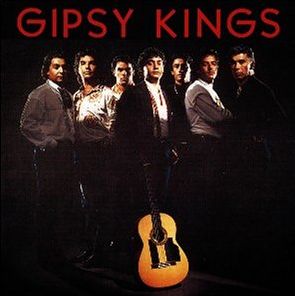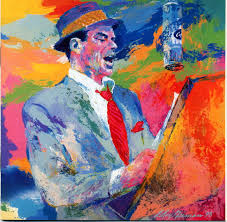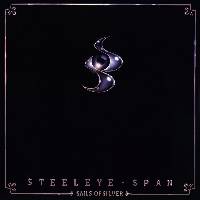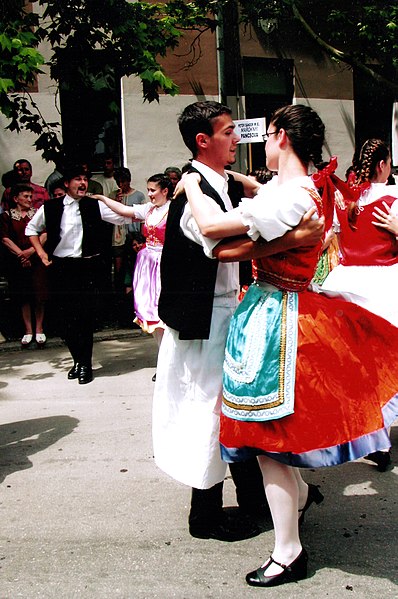What can I say about
Steeley Span. I first saw them on a TV show in the US and was blown away by their sound and
Maddy Prior who was and is the lead singer. I immediately went and bought the vynil album called Parcel Of Rogues.
I really enjoyed their sound and their updating the British Folk idiom to a rock instrumentation.
Steeleye Span are an
English folk-rock band, formed in 1969 and remaining active today. Along with
Fairport Convention they are amongst the best known acts of the British folk revival, and were among the most commercially successful, thanks to their hit singles "
Gaudete" and "
All Around My Hat". They had 3 top 40 albums. They achieved a certified "gold" record with sales of "All Around My Hat".
The name Steeleye Span comes from a character in the traditional song
Horkstow Grange (which they did not actually record until they released an
album by that name in 1998). The song gives an account of a fight between John "Steeleye" Span and John Bowlin, neither of whom are proven to have been real people.
Martin Carthy gave
Tim Hart the idea to name the band after the song character. When the band discussed names, they decided to vote between the three suggestions "Middlemarch Wait", "Iyubidin's Wait", and "Steeleye Span". Although there were only five members in the band, six ballots appeared and "Steeleye Span" won out. Only in 1978 did Hart confess that he had voted twice.
Their typical album is a collection of mostly traditional songs with one or two instrumental tracks of
jigs and/or reels added; the traditional songs often include some of the
Child ballads. In their later albums there has been an increased tendency to include music written by the band members, but they have never got completely away from traditional music, which draws upon pan-British traditions.
Sails of Silver was produced two years after the band's ostensible break-up, at the request of Chrysalis Records. Peter Knight and Bob Johnson both returned, replacing their own replacements Martin Carthy and John Kirkpatrick, who had departed after the release of
Live at Last. However, although Chrysalis had prodded the band to reform and release the album, in practice the label proved much more interested in promoting rising acts like
Blondie than a reformed band that hadn't hit a real hit in four years. Despite being produced by Elton John's producer Gus Dudgeon,
Sails of Silver was a commercial failure, and this proved a final straw for Tim Hart, who departed the band, leaving Maddy Prior as the band's sole remaining founding member.
The personnel on this recording were:
The tracks are as follows:
"Sails of Silver" (
Tim Hart,
Bob Johnson,
Rick Kemp,
Peter Knight,
Nigel Pegrum,
Maddy Prior) – 3:27 This is a song written by the band.
Fair maid in a
]garden
]walking along,
What is it
makes her to
weep and to
mourn?
]I am as a
tall sailing
ship out on the
sea,
Where only
long breezes
reach out to
me.
Chorus
And I'll set my sails of silver,
And I'll steer towards the sun,
And you false
love will weep for me
When I'm gone, when I'm gone, when I'm gone.
Verse 2
Fair maid in a garden how can it be?
Eyes staring seaward but what does she see?
A mast of the tall rowan tree, ropes of fine silk,
Decks holy stoned shining whiter than milk.
"My Love" (Traditional, Steeleye Span) – 2:52
Do you remember what we promised when we met, my love?
There would never be a reason for regret, my love;
The news has come to town, the news flies up and down,
That another you have found to lie with you, my love.
If the wind doth whisper by that it's not true, my love,
And the seas could rise and cry that it's not you, my love;
If the hills could only say that you were on your way,
Then happy I would stay and be with you, my love.
"Barnet Fair"(Kemp, Traditional) – 4:34
Barnet Fair is an annual horse and pleasure fair held in
Barnet on the first Monday in September.
It began in 1588 when
Queen Elizabeth I granted a charter to the Lord of the Manor of Barnet to hold a fair twice yearly, in addition to the weekly
Barnet Market. Originally held in June and October, Lord John Tomlinson changed the dates to April and September in 1758 for the reason of improving business
Verse 1
Once a year when the Winter's calling,
Birds fly south and the leaves are falling down
Just beyond the town, the meadow where a campfire's burning
Wakes in the morning to the music of the big fairground.
Coming from the
East, coming from the West, all the gypsies are gathering.
Just another town on the road for the travelling man
Chorus
Follow me, boys, won't you follow me to Barnet Fair?
Follow on children won't you follow me to Barnet Fair?
If I show you the way won't you come along today?
Everyone you know will be there.
Follow me, boys, won't you follow me to Barnet
Fair.
Verse 2
Leave the factory, leave the field
Word is abroad that the fair arrives today.
Come on from the dusty loom and the rusty plough
Join the procession, I can hear it come this way
Come and see the juggler, come and see the fiddler
See the horses and the dancing bear.
Come and see the pretty lasses with the coloured ribbons in their hair.
Chorus
Verse 3
See the magic lantern and the batt and hoop-la,
Prizes for the twopenny shy.
"All the fun of the fair" you can hear the showmen cry.
Chorus
"Senior Service" (Kemp, Prior) – 3:30
Sally's in the alley and Nancy's on the game
Emily is pregnant and wondering who to blame.
We raise our port and lemon and toast a reply
That the Senior Service satisfy.
Verse 1
See the bold man-of-war steaming into port
Guns fully primed, the 24-pounder sort
And down on the deck for a full broadside
Back on the high seas with the rising tide.
Verse 2
Here's a little steam ship chugging up the channel
Small smoke stack and a red smoking funnel.
He brings the girls presents of stockings and tights,
Comes regular as clockwork every Tuesday night.
Chorus
Here come the sailor boys, Matthew, Luke and John
I like 'em with tattoos, I like 'em young and strong.
Here come the sailor boys a-rousting up the town
Their rigging is up but their sails are down.
Instrumental Break
Verse 3
Here's a skipper of a clipper with a broken bowsprit
Heading for dry dock and a new refit
There's an oil tanker of the modern kind
A thousand foot length of throbbing steam turbine.
Chorus
Here come the sailor boys, George, John and Paul.
I like 'em lithe and lissom, like 'em slim and tall.
Here come the sailor boys whistling up the quay,
Blue Peter up the mast where all the girls can see.
"Gone to America" (Knight, Traditional) – 4:22
Married him in April, lost him in
July
Listen to my story and I'll tell you why
They said that he'd been poaching and stealing wine
They
said I wouldn't see him for a long, long time
Chorus
They said he's gone to America
To work the land that
some called Virginia
They said he's gone to America
Verse 2
Married him in April, lost him in July
They took him as their prisoner then told me why
They said that they had sent him where poachers go,
I asked if I could see him, but they said no,
Chorus
Married him in April, lost him in July
Instrumental
Verse 3
Married him in April, lost him in July
Curse the men who took him curse their wicked lies
The night they saw him poaching and stealing wine
Was the night that he took comfort in these arms of mine, but now:
"Where Are They Now" (Kemp, Traditional) – 4:10
And his Nature was his mother
Made a promise at his birth
But she's running like a hunted mob for cover
All across the earth
The forest turned into the tall ships
And though they fought for England well
The emptiness is ringing down the ages
Like a hollow bell
Where are they now
A Mystery
The hearts I hear of the mountaineers
Are lost on the breeze
Where are they now
"
Let Her Go Down" (Knight) – 3:36
Let Her Go Down is a song written by
Peter Knight and originally recorded by
Steeleye Span. The song features on the band's 1980 album
Sails of Silver, and tells the story of how weather can quickly change at sea. Indeed, Knight wrote the song after experiencing fishing in the
English Channel. Let Her Go Down was released as a 7" single in 1980, but failed to chart. A version of the song was recorded by
The Hollies and featured as a rare B-side. The song was included as part of their 6CD "Long Road Home" compilation released in 2003.
Sometime in October,
We sailed from England's shore,
When we sailed into a raging storm
Like I've never ever seen before;
And all of the crew they were brave men,
But the captain, he was braver,
He said "Never mind the ship, me boys,
There's none of us here can save her."
Chorus: Let her go down,
Swim for your lives,
Swim for your children,
Swim for your wives,
But let her go down,
Just let her go down.
Lost in the open ocean,
There were some of the crew and me,
While the captain steered our wounded ship,
To the bottom of an angry sea,
And with his dying breath we all heard him say,
"Just the fortunes of a sailor."
And he said "Never mind the ship, me boys,
There's none of us here can save her."
Chorus:
He wondered if his shipmates
were ready just to pray and give in,
So he called their names out one by one,
But there was no one else around but him,
He saw the ship go down in the fading light,
And he knew they couldn't save her.
He said "The captain lied when the captain cried,
There's none of us here can save her."
Chorus:
"Longbone" (Hart, Johnson, Kemp, Knight, Pegrum, Prior)– 3:57
There was a king who built a ship
And Sailed away
To look for gold in the hills of Scone
Far away
The only gold in the hills of Scone
Is gold you'll never own
It belongs to the giant longbone
Far Away
The only gold I've ever known
It all belonged to the giant longbone
His teeth are sharp, His claws are long
So they Say
His eyes are like a fire that burns
Far Away
We wil go to the Hills of Scone
We'll find the giant Longbone
We'll turn him into stone
The only gold I've ever known
It all belonged to the giant longbone
Through the rain and through the snow
We sailed away
To the land where only fools go
Far Away
We stepped onto the shore
And then we heard him roar
He must have seen us
We tried to hide, we tried to run
Run away
He killed the crew, he threw the boat
And then he said we are alone
I am the giant Longbone
You should have stayed at home
Far Away
The only gold I've ever known
It all belonged to the giant Longbone.
"Marigold/Harvest Home" (Knight, Prior, Steeleye Span)– 3:05
Marigold
When the marigold no longer blooms
When summer sun is turned to gloom
See the forecast winter snow
See the evergreen that lonely grows
Move close to the fireplace
Neglect the garden
See the ground harden
At a ghostly place
The golden summer sun is silver now
The fruit has fallen from the bough
The season moves to chestnut time
Toffee apples, treacle and mulled wine
Quilts and furs and woolens gay
You wrap around you
But the cold confounds you
On an autumn day
Stout and strong the walls of home and hearth
Curtains drawn against the draft
The rake has reaped, the blade has mown
Nights draw in to call the harvest home
The quiet of a heart at rest
In peace abounded
By love surrounded
Here the home is blest
Harvest Home:
Come, ye thankful people, come
Raise the song of harvest home
All be safely gathered in
Ere the winter storms begin
God, our Maker doth provide
For our wants to be supplied
Come, ye thankful people, come
Raise the song of harvest home
"Tell Me Why" (Steeleye Span, Traditional)– 3:54
What is deeper than the sea
What is higher than a tree
And waht is louder than a horn
What is sharper than a thorn
What is lighter than the light
What is darker than the night
What is colder than the clay
What is broader than the way
Tell me why
So many questions
Tell me why
The devil lies
Tell me why
Who will live or who will die
Tell me why
So many questions
Tell me why the devil lies
Tell me why
Which way leads to paradise
Tell me why
Tell me why
Hell is deeper than the sea
Heaven is higher than the tree
And thunder is louder than a horn
Hunger is sharper than a thorn
Truth is lighter than the light
The devil is darker than the night
And death is colder than the clay
Love is broader than the way
Tell me why
So many questions
Tell me why
The devil lies
Tell me why
Who will live or who will die
Tell me why
So many questions
Tell me why the devil lies
Tell me why
Which way leads to paradise
Tell me why
Live or die
Tell me why
Please watch the videos below to get more of Steeleye Span.






